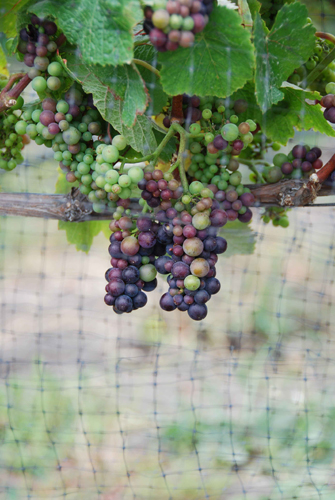Another Year in the Vineyard, Week #18
July 8-15, 2009
By Wes Hagen, VM/WM Clos Pepe
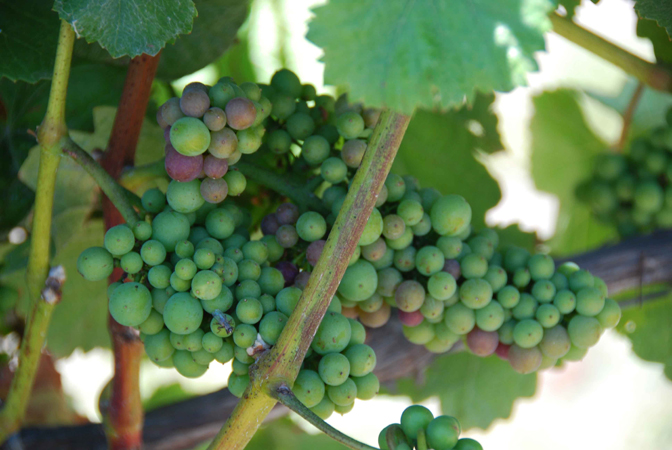
Vintage:
The 2010 vintage rolls along and gets a bump of heat. Temps warmed from the mid to high 60’s last week to the mid to high 70’s this week. The difference is considerable for the physiology of the vine, and we are seeing a distinct change in the vines as they stop their vegetative growth and start using the sun for the production of sugar in the berries and the maturation of the seeds. Nature never lies. The moment that the grape seeds become viable, the berries turn color and soften. This is much easier to see in Pinot Noir, but chardonnay goes from a hard, light lime color to a more translucent gold-green. The color change is a marker to the birds more than a precursor for ripeness and a lovely color in red wine. Grapevines have no interest in humans and winemaking, as we do not ingest the seeds and leave them behind in the forest after they pass through our gut. Birds and squirrels do, however, eat colored berries and drop the seeds in various locations, and that’s what the vines are really encouraging by producing sugar and color. A vine is just a bird/squirrel feeder. Ever see a random vine growing up a tree or in a shrub-laden area a few hundred yards from a commercial vineyard. Ever wonder how that vine got there? A bird or squirrel stole some grapes (yes, they can grab a few berries through bird netting if they are skilled), took a rest on a branch or a bush, and pooped out a few seeds. Those seeds very rarely germinate—they need moist soil and shade to have any chance of living..so landscaped/irrigated areas are usually the only places in California that a vine can go ‘feral’. But this is how vines expanded their natural habitat in the ancient world. The seeds traveled the area between the Black Sea and Caspian Sea in the bellies of birds, where they were deposited in new areas of temperate forests in a lump of moist fertilizer. How I went from a heat bump to bird poop in 300 words is a mystery to me, but I find it an entertaining sidenote in the history of the grapevine.
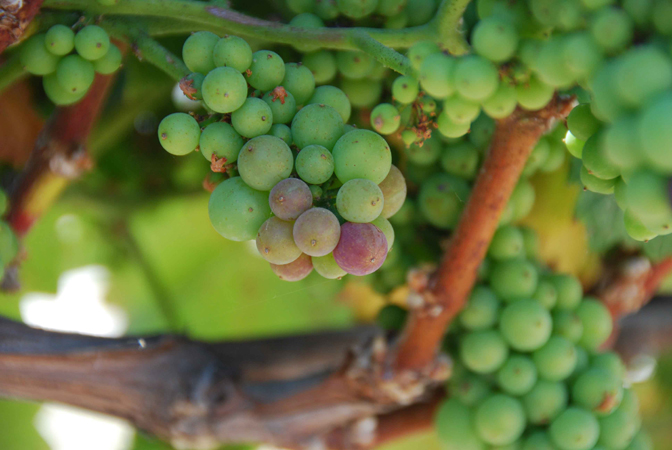
The take-home message is that we are seeing the first blushing berries, and that gets me all flustered and excited, and worried that the massive flocks of starlings may come visiting and snacking. Nets, propane cannons and my 12-gauge will be my protection, and if I have to I will stand at the entrance of the property with my shotgun and slam the butt on the ground like Gandalf to a Balrog (that’s Lord of the Rings talk if you’re not a geek) and scream ‘YOU SHALL NOT PASS!’.

European starlings are a horrible pest, and it’s all Shakespeare’s fault that they are here in the US. Really, I’m not kidding. The American Acclimatization Society decided in the late 1800’s (proving that book smarts and the ability to get through his pre-1600 historical plays, do not prove wisdom of any sort) that every bird that appears in a Shakespeare play should also flutter through Central Park in New York. So they imported (sigh) the European Starling, which is now considered the nastiest agricultural pest in the entire country, maybe the world. In the late 1590s Shakespeare noted the mimicking ability of the starling while writing Henry IV, Part 1. Hotspur is contemplating driving King Henry nuts by having a starling repeat the name of Hotspur’s brother-in-law Mortimer, whom Henry refuses to ransom out of prisoner status. “Nay, I’ll have a starling shall be taught to speak nothing but ‘Mortimer,’ ”. And that’s all it took. A few released starlings flew and bred all over the US, and now number more than 200 million. One stroke of the Bard’s pen and now we have to net 29 miles of vines. But for the benefit of King Henry, I mutter ‘Mortimer’ each time I have to buttress the effectiveness of the nets and cannons with a few shotgun blasts. ‘Mortimer’ will be called out as my version of ‘pull’. Amazing that even the story of a nasty agricultural pest can be traced back to something as random as a line in a Shakespeare play.
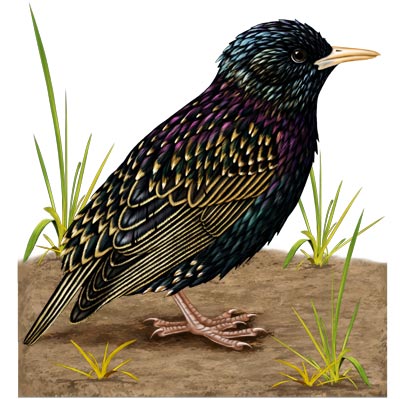
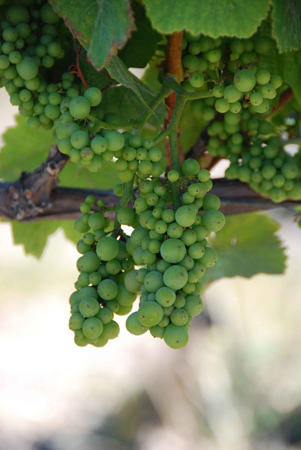
The crew is finished with the last pass of canopy management. They have made the following passes this year, through 29 linear miles of grapevines (over 40,000 in total):
- Suckering and shoot removal (double shoots snapped off, crowded and stunted shoots removed)
- Head cleaning, suckering and early shoot positioning (into vertically positioned wires to expose the clusters and developing buds to sun and wind).
- Shoot positioning. (all shoots tucked vertically to form a solar panel for light collection).
- 75% leaf pulling on the east (morning side) and west side leaf removal to a single leaf layer between the sun and the fruit. At this point we should have about 60% canopy gaps, meaning you should be able to see open space through 60% of the area where the primary crop is hanging. During this pass we also pull crowded shoots and head suckers/ basal shoots we missed in previous passes. We also remove lateral shoots that grow off the primary shoots. We also focused on ‘scooping’, which involved removing all interior leaves first before going to the outside leaves. The 100% leaf removal that used to be the norm at Clos Pepe has been replaced with 75% leafing on the east side, and about 25% on the west side to protect the fruit from sunburn and skin cracking during heat spikes.
- Last pass is a 25% leaf removal on the west (afternoon sun) side. At this point the canopy management is complete and the vines have an open canopy for sun penetration and flavor improvement, but enough protection that the fruit will not burn in the hottest parts of the day.
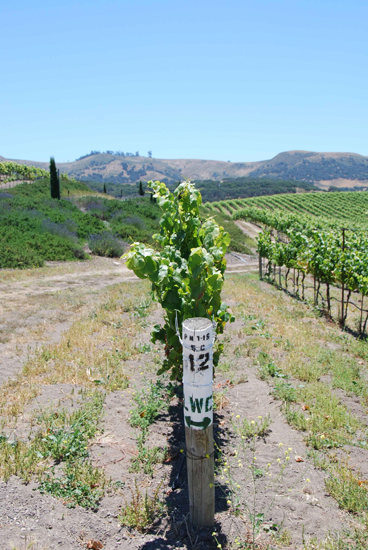
Now we continue doing weed removal and getting the vineyard ready to put up bird nets. Once the nets are bundled and tied from underneath (to exclude climbing squirrels and clever birds), we will be able to run a tractor through the vineyard again. We finished spraying our last application of fungicide on Tuesday, and mildew will not grow on fruit after it changes color and softens. We will likely spray one last time for botrytis once the nets are up, bundled and tied, which takes about three weeks. Applying 29 miles of netting and tying it is a hot, dusty and miserable job, so I plan to call Tony the intern and get him involved. He needs the discipline.
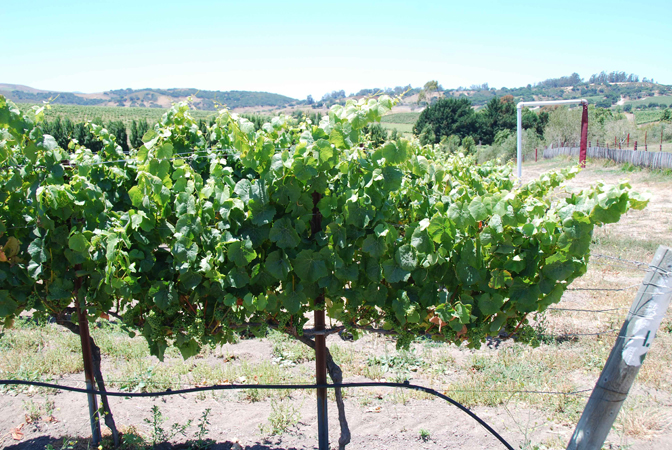
Wine and Vampirism.
Now as things slow down just a bit in the vineyard, I have a little time to consider more esoteric subjects to blog on. The canopy management is done, the fruit is starting to color and we’ll get the nets up and tied over the rest of July. Then we sit, wait, test fruit, clean the winery, pick up the interns at the airport, and maybe tool around the county a bit teaching a Frenchy (Adrien Gautherin, 7th generation Chablis winemaker) what Central Coast wine is all about. But back to the esoteric.


This whole Twilight Saga trend has really driven the country’s imagination to blood sucking, and it may not be surprising to learn that vampirism has a direct relationship with drinking red wine. Many aboriginal cultures, Europeans included (even down to the Golden Age of Greece), believed that drinking the blood of a defeated foe would imbue a warrior with the strength of the fallen. The act of feeding on the blood of another creature, human or not, is called hematophagy. Red wine has been used as a proxy for blood since ancient times, perhaps even before written history. We know from archaeology that red wine was being crafted, transported in fired pottery containers, and traded by the 7th Millennia BCE. You read that correctly. Wine has been a human commodity for almost 10,000 years. It is certainly a civilizing beverage. I believe (and there is a bit of educated conjecture included) that wine civilized courtship, as it was preferable to offer an intoxicating/aphrodisiac tipple to knocking a potential mate over the head and dragging him/her back to the hut. It also became a perfect stand-in for those cultures that were tired of drinking the blood of their slain enemies. These Paleolithic and Neolithic clans were intensely devoted to the practice of sympathetic magic. Putting a thorn in the footprint of an enemy was believed to give them a pain in their foot. And because wine looked like blood, and was considered the blood of the vine, and thereby the blood of the earth, wine was likely used as proxy-blood as early as the Neolithic period.
Up until Shakespeare’s day it was believed that drinking wine could strengthen the blood, and even replace lost blood in a human. Back in the hazy days of prehistory it is easy to imagine that the violent and uncivilized practice of imbibing blood of the slain enemy (practiced into the Common Era by violent tribes like the Scythians) slowly evolved into ritual red wine drinking. Grape wine is a perfect symbol for death and rebirth. The grapes are crushed (killed) near the end of the calendar year, and then nature resurrects the juice with yeast (a process never understood scientifically until Pasteur in the 19th Century). Then the ‘resurrected’ juice (wine) magically transforms our own consciousness from the earthly and mundane to a state of heavenly ecstasy. One can only imagine how mysterious and religious the natural transformation of grape juice into wine would have seemed to ancient cultures. Clearly this was the blood of the gods, delivered through the vine, through the grape and into a red liquid that (especially with a lack of filtration and fining) really did look like blood.
Of course hematophagy is still practiced almost every Sunday in nearly every country in the world through the Catholic and Christian Eucharist. Through a quasi-vampiric ritual, millions of Christ’s followers drink his blood in a distinctly pagan, Neolithic-era ritual of attempting to steal the essence of their God’s potency and piety through the consumption of his blood. Catholics even believe what they are drinking is actually, literally and honestly the blood of Christ that has undergone the process of transubstantiation. (I guess they all pretend that the wine in the chalice doesn’t really taste like wine, because yelling out ‘Bullshit!’ during High Mass is likely discouraged.) It’s almost comical to read all of the differing beliefs of the Protestant churches to what the wine becomes, is or is not. What I know is that wine has represented the elevation of consciousness from the earthly to the divine for nearly 10,000 years, and no church can lay claim to that invention.
Wine is a miracle on so many levels. It has enticed mankind from drinking the blood of his enemies, it has taught us the concept of heaven (I would argue that without wine, the concept of heaven would never have been invented), and as shown by the cults of Dionysus and Bacchus—wine can represent the most noble, learned and romantic aspects of humanity as well as the most violent, base and rapacious. It is up to us how wine affects our life, and I humbly suggest that it be a civilizing, gracious influence on your life—a blessing at table that brings food, friends and families together. Wine is the magical, poetic and literal blood of the earth—proof that she wants humans to be happy and in love.



